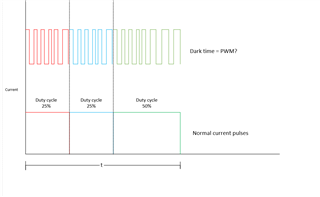Other Parts Discussed in Thread: DLPC3433, DLPA2005, DLPA2000, DLPC3438
Currently using DLPC3433, DLPA2005, DLP3010
Needing to get brightness to a very low limit of 0.01fL to 50fL. We are using a projector system to project through a waveguide. There is some light inefficiencies with the waveguide itself but we cant seem to get the brightness low enough for our application.
DLPA2005 appears the lowest setting is 100mA and DLPA2000 is 14mA.
Using DLPA2000 we still cant get brightness low enough for our application. We still need roughly 600mA to hit our applications' max brightness.
Is there a ways to reduce the brightness even more with DLPA2000?
- possibly changing the duty cycle of each LED? currently G50% R25% B25%
- adjusting LED current via I2C DLPC
- would additional circuitry to change duty cycle cause dlpa2000 to not function properly?
- is there a limitation of how much light is needed for the DMD micro-mirrors?
- Different LED drivers options available?


